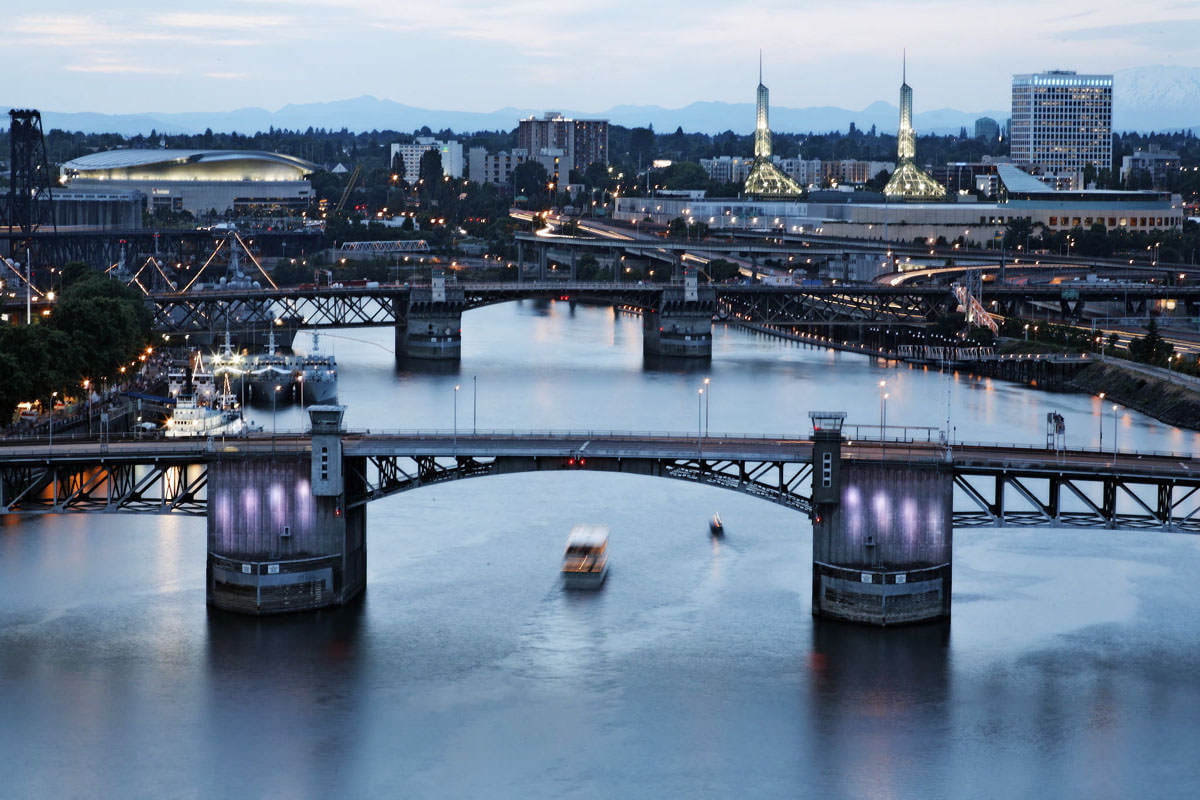
Bridge Stats
- Mile: 12.7
- Opened: May 24, 1958, 1905, 1887
- Type: Double-leaf Chicago-type, fixed trunnion, Bascule
- Engineers/Designers: Sverdrup & Parcel (MO),Moffatt, Nichol & Taylor of Portland
- Owner: Multnomah County
- Total Length: 760’ (deck truss not approaches)
- Main strong Length: 284’ 5”
- Counterweights: 2 Counterweights @ 950 tons each (1,900,000 pounds)
- GPS Coordinates: 45.517810, -122.669584
Light the Morrison Bridge!
WHAT THE WLB DID
The Willamette Light Brigade undertook the project of upgrading and restoring the lighting fixtures on the Morrison Bridge. This upgrade was made possible by a generous donation by Greven. The WLB manages the public lighting of the Morrison Bridge for private events, organizations, causes and sports events. Individuals and organizations can light the bridge with colors of their choosing
The National Electrical Contractors Association (NECA) and the local members of the International Brotherhood of Electrical Workers (IBEW) approached the Willamette Light Brigade with an offer to light the Morrison Bridge piers. WLB accepted with enthusiasm. On December 12, 1987 at a grand public celebration (which included singing carols afterwards), flood lights with color filters were first beamed on the north and south piers of that mid-town bascule bridge.
ABOUT THE MORRISON
The Morrison was Portland’s first bridge and it operated as a toll bridge. The current design is the third bridge at this location. Both of the previous structures (1887 and 1905) were swing spans; this last moveable bridge built on the Willamette in Portland has bascule spans which can be tilted up. Design work for the six-lane, three-span, steel deck truss structure began in 1928. It was built for $12,841,256 and opened in 1958. Like Morrison St., the bridge was named for a Methodist missionary from Scotland who built the first house on that thoroughfare.
The Morrison is structurally like the Burnside, but without ornamentation in its railing or its pair of bridge houses (also mounted on the south face). It serves as a major travel corridor link between SE Portland and inner-city Portland and to Interstate 5.
When river traffic requires that the bridge open, a controller inside the western bridge house operates a below-deck rack and pinion system and gears 36 feet tall. That system lifts and returns the Morrison’s double-leaf bascule spans (each 150 feet long) by means of counterweights, one set for each side. The roadway’s open metal grating was replaced with fiberglass in 2011-12 to further reduce its weight, but hundreds of tons of counterweights are still required to balance the bascule halves.
THE ARCHITECTURAL LIGHTS
The first lighting system, designed by PAE Engineering and installed in December of 1987, consisted of 16 white floodlights fixed to the north and south piers many feet below the deck. To add color a theatrical gel was placed in a filter attached to each fixture. The bulbs and the gels were short-lived. Each replacement was risky and expensive because it required suspending a worker below deck, with tools and supplies, to hang while tending each fixture.
As lighting technology advanced Ed Slavin of Northern Illumination Company led WLB’s efforts to upgrade that first system. Now 32 UHB (Ultra High Brightness) LED (Light Emitting Diodes) fixtures vastly reduce energy use and maintenance costs. They use 1/8 the energy of the floodlights. The bulbs should last about 25 years (run an average of 8 hours/day). The fixtures have been hung on brackets designed by the Multnomah County Bridge Shop which allow them to be swung up onto the bridge deck for maintenance. Also, these LEDs can be reprogrammed for a wide range of colors and timing patterns from a Bridge Shop computer keyboard, further reducing labor to a minimum.
Cost of the fixtures and labor to install the 1987 system were donated by the International Brotherhood of Electrical Workers and the National Electrical Contractors Association. An anonymous donation on behalf of WLB volunteers launched the upgrade efforts. Although the LEDs were costly, their energy efficiency and WLB’s purchase of alternative energy for all its lighting systems so pleased Pacific Power that it donated $50,000 to complete the project. Pacific Power also hosted the LED “lights-on” party on February 14, 2007.
COMMUNITY PARTICIPATION
WLB felt that the ease of computerized timing and color changes made it feasible to involve the public in choosing lighting designs for the Morrison. Commissioner Deborah Kafoury and her chief of staff Beckie Lee championed the Lighting Partner program to do just that. It is administered by WLB.


